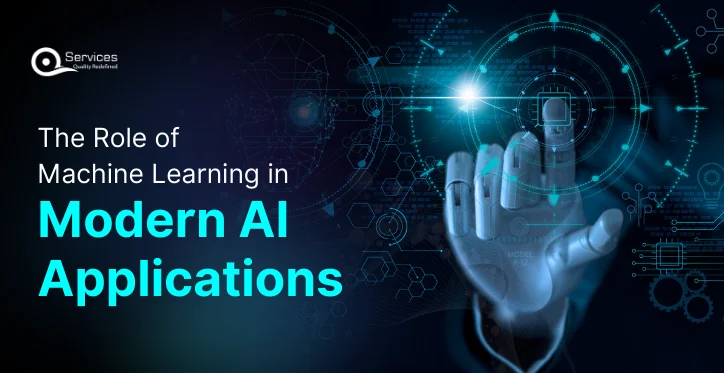
Rewards
.





CANADA
55 Village Center Place, Suite 307 Bldg 4287,
Mississauga ON L4Z 1V9, Canada
Certified Members:
.



Home » The Role of Machine Learning in Modern AI Applications

We live in a world where apps seem to know us better than we know ourselves. How does your streaming platform recommend the perfect movie? How does a chatbot understand your question? It’s all thanks to Machine Learning (ML), the magic behind modern Artificial Intelligence (AI).
Machine learning takes AI to the next level, leveraging systems to learn from data, improve over time, and adapt to what we need. But why machine learning in software development important? What makes it the key to building smarter, faster, and more reliable AI applications?
In this blog, we’ll break it all down—how machine learning software development works, how it powers AI technologies, and where it’s making the biggest impact in the real world.
Machine Learning is a vital element of AI that enable machines to learn from data and become more adaptive over time. Unlike traditional programming, where tasks are explicitly coded, Machine Learning lets systems evolve by analyzing patterns and making predictions. It’s how technologies like facial recognition, spam filters, and personalized recommendations work seamlessly.
ML takes AI to the next level by:
Thanks to ML, AI is more than just smart—it’s adaptive and constantly improving.
By understanding ML’s role in AI, it’s easier to see how these technologies work together to shape intelligent solutions.
Get free Consultation and let us know your project idea to turn into an amazing digital product.
Machine learning (ML) is changing how we build software. Instead of just following fixed rules, ML allows software to learn from data and get smarter over time. This makes software more adaptive and capable of performing tasks that would be really tough or time-consuming to program manually.
In the past, developers would write every line of code to handle specific tasks. Now, with ML, we can teach software to learn from data. For example, apps can recommend products, predict future trends, or even respond to user needs in real-time, all based on past experiences.
First, you gather all the data you need (like user actions or past trends).
Then, developers train a model using that data so it can make predictions or decisions.
As the app gets more data, it gets better and smarter, continuously improving.
ML works alongside traditional programming, blending the best of both worlds to build smarter, more stable software.
ML can do repetitive tasks like finding bugs or suggesting improvements.
Ever noticed how Netflix always recommends shows you’ll love? That’s ML in action.
In things like self-driving cars, ML helps systems adapt instantly to new data.
ML can analyze patterns and predict what might happen next, like in finance or healthcare.
ML helps doctors make better decisions by analyzing medical data and predicting diseases.
Machine Learning already being applied across a variety of industries, shaping the future of artificial intelligence (AI) technologies. Let’s explore how it’s changing the game.
With the help of Machine Learning doctors can detect diseases early by analyzing medical images and patient data, improving diagnosis and treatment.
ML algorithms spot fraud and predict market trends by analyzing transaction patterns, keeping financial systems secure and efficient.
Think personalized shopping! ML looks at your browsing history and recommends products you’re likely to buy, improving the customer experience.
Autonomous cars and drones use ML to navigate safely, learning from real-time data to make better driving decisions.
ML predicts when machines need maintenance, preventing breakdowns and reducing downtime. It also helps optimize production processes.
Machine learning is like the engine behind artificial intelligence, making AI smarter by allowing it to learn and improve on its own over time. Here’s how it’s changing the game:
AI can now makes more accurate decisions thanks to machine learning, which helps it analyze tons of data quickly. This is especially useful in areas like finance, where AI can predict market trends or detect fraud.
Ever noticed how Netflix or Amazon knows exactly what you want to watch or buy? That’s machine learning! It helps AI recommend personalized content based on your past choices.
AI, powered by ML, can now automate boring tasks like sorting emails or scheduling meetings. This frees up time for people to focus on more important work.
Machine learning allows AI to learn instantly from new data. This is important for things like self-driving cars, which need to make quick decisions based on real-time information.
Machine learning is helping AI tackle global challenges, from predicting natural disasters to improving healthcare treatments, by finding patterns in data that humans might miss.
ML helps doctors with cancer diagnosis by analyzing huge amounts of medical data and suggesting treatments.
ML allows Waymo’s cars to learn from millions of miles driven and adapt to traffic, making driving safer.
PayPal uses ML to detect suspicious transactions in real-time, protecting users from fraud.
Spotify uses ML to suggest music you’ll love, based on your listening habits.
GE uses ML to predict when machines will break down, preventing costly repairs and optimizing operations.
Machine learning (ML) is seriously changing the game when it comes to AI. It’s what makes AI so smart and capable of handling all sorts of complex tasks. But how exactly does it work? Let’s break down the main ML techniques that are boosting AI and making applications smarter every day.
Supervised learning is where the AI learns from examples. It’s like showing the AI a bunch of photos of cats and dogs and telling it, which is which, so it can figure it out on its own next time.
This is great for things like email spam filters, fraud detection, or anything where we want to classify or predict something based on past data.
Unsupervised learning is when the AI doesn’t get the answers up front. Instead, it looks at the data and tries to find patterns all on its own. No human labels required.
This technique is perfect for grouping similar things together, like clustering customers based on behavior or finding hidden trends in data.
In reinforcement learning, the AI learns by trial and error. It makes decisions, gets feedback, and adjusts accordingly to improve over time—kind of like a game where you level up as you go.
This is super useful for things like robotics, self-driving cars, or even game AI, where the system learns to make better decisions the more it plays or experiences.
So, how exactly does machine learning enhance modern AI applications? Let’s look at how these techniques are being used to make software smarter and more efficient in different industries:
Machine learning isn’t just about making AI smarter—it also makes software better in a couple of really important ways:
ML allows AI systems to handle huge amounts of data without slowing down. Whether it’s sorting through user data, analyzing traffic patterns, or monitoring health data, how machine learning enhances modern AI applications means it can scale up to handle even the biggest challenges.
The more data AI gets, the more accurate it becomes. Techniques like supervised learning improve decision-making, making AI systems more precise in things like diagnosing diseases or predicting stock market trends.
When we talk about creating next-generation technology, artificial intelligence and machine learning engineers are the ones leading the way. They combine AI’s decision-making power with the adaptability of Machine Learning to build systems that can learn and evolve.
In fields like healthcare, automotive, and finance, AI and ML engineers are finding innovative ways to improve processes, predict future trends, and even create smarter products. For example, predictive maintenance in machinery or AI-driven diagnostics in healthcare are all thanks to the breakthroughs these engineers bring.
By combining AI with ML, they’re not just solving problems—they’re changing how industries operate and opening doors to a whole new world of possibilities.
Machine learning is considered a game-changer for AI, but like any new or advanced technology, it comes with its own set of challenges. As it keeps growing and improving, there are a few key hurdles to overcome to make sure it reaches its full potential.
One major issue with ML is bias. Since ML algorithms learn from data, if that data is biased, the models will be too. This can lead to unfair or even discriminatory decisions, like in hiring practices or credit scoring. It’s something that’s being worked on, but it’s a tough problem to fix.
ML relies on huge amounts of data, and with that comes the risk of data breaches. Keeping personal data safe and secure is a big challenge, especially as more sensitive data gets used to train AI models.
Training ML models needs a lot of computing power. This means it can be expensive and requires a lot of resources, which isn’t always accessible for everyone.
The future of ML in AI is super exciting, with lots of cool trends popping up that could change how we interact with technology:
One growing trend is the push for explainable AI. As ML models get more complicated, it becomes harder to understand how they make decisions. Explainable AI is all about making those decisions clearer, so we can trust the system more and know where things might go wrong.
With federated learning, we can train models on different devices (like your phone) without sending all the data to the cloud. This helps with privacy and makes things faster since the data stays on the device.
As more devices (think smart speakers, wearables, etc.) get connected, processing data closer to the source (on the device itself) is becoming a bigger deal. This trend, called Edge AI, reduces the lag and makes everything work faster and more securely.

Looking ahead, machine learning is going to keep pushing AI into new territory. Here’s how it’s going to shape the future:
ML is already automating a lot of tasks, but as it gets better, it’ll automate even more complex processes—like predicting market trends or diagnosing medical conditions. This means businesses can save time and money, and people can focus on more interesting work.
ML will continue to make experiences more personal. From tailored recommendations on shopping sites to customized newsfeeds, it’ll get even better at understanding what we like and need.
Imagine AI systems that get better on their own without needing much human help. That’s the future we’re heading toward, where machines not only learn from data but also adapt to changing conditions on their own.
Machine learning’s contribution to the development of intelligent applications is making a great impact across industries. It’s what helps apps become smarter over time by learning from user behaviour and adjusting to their needs. Whether you’re using AI for predictive analytics or developing a self-driving car, machine learning makes it all possible by driving innovation and better decision-making in real time. For anyone building the AI apps of the future, machine learning is a must-have.

Dynamics 365 CRM for Financial Services is a specialized version of Microsoft Dynamics 365 Customer Relationship Management (CRM) tailored specifically for the financial services industry. It is designed to help financial institutions, such as banks, insurance companies, investment firms, and wealth management organizations, manage their customer relationships, streamline operations, and enhance service delivery.

Companies are catching on to the fact that they need cool tech like Dynamics 365 CRM and ReactJS if they want to keep things running smooth and make smarter choices.

This blog discusses how generative AI can be combined with MongoDB to turn the risk management in finance into an intelligent, streamlined, and scalable practice.
Machine learning is used in applications such as image and speech recognition, natural language processing, recommendation systems, and autonomous vehicles.
Neural networks, especially deep neural networks, are used to model complex patterns in data, enabling advancements in image and speech recognition.
Machine learning models are used in NLP to understand, interpret, and generate human language, enabling applications like chatbots and translation.
Machine learning models, especially convolutional neural networks (CNNs), are trained on large datasets to accurately identify and classify images.
Machine learning models detect anomalies and potential threats by analyzing network traffic and user behavior.
Big data provides the large volumes of data needed to train machine learning models, improving their accuracy and reliability.
Machine learning algorithms analyze player performance and game data to provide insights for strategy and training.
Machine learning models, especially recurrent neural networks (RNNs), are trained to accurately transcribe spoken language.
Reinforcement learning enables AI agents to learn optimal strategies through trial and error, used in robotics and gaming.
Machine learning models improve object recognition and interaction in VR and AR environments, creating more immersive experiences.
.





55 Village Center Place, Suite 307 Bldg 4287,
Mississauga ON L4Z 1V9, Canada
.




Founder and CEO

Chief Sales Officer

🎉 Thank you for your feedback! We appreciate it. 🙌